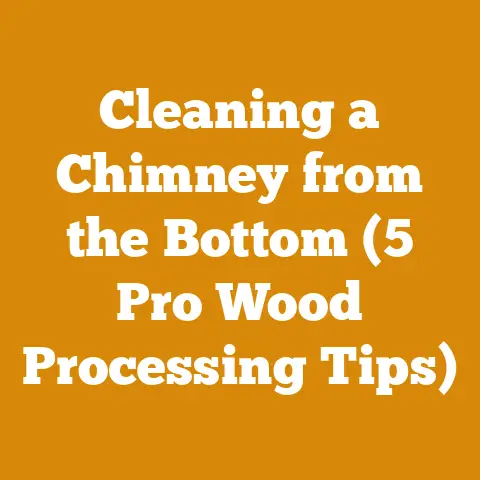Is Cypress Good Firewood? (5 Arborist Tips You Must Know)
Ever been stuck on a chilly evening, staring at a pile of wood, wondering if it’s even worth your effort to throw it in the fireplace? I’ve been there. Choosing the right firewood can be the difference between a cozy night and a frustrating battle against smoke and weak flames. Cypress is a wood I’ve often encountered in my work, and it’s prompted a lot of questions. So, is cypress good firewood? Let’s dive into the facts and myths, and I’ll share some arborist tips that I’ve picked up over the years.
Is Cypress Good Firewood? (5 Arborist Tips You Must Know)
Cypress is a common wood, especially in wetter regions. I’ve personally harvested cypress from swampy areas where other hardwoods struggle to thrive. However, just because it’s available doesn’t automatically make it ideal for your fireplace. Understanding its properties is crucial.
1. Understanding Cypress Wood Properties
Cypress is a softwood, but it’s not like pine or fir. It contains natural oils that make it surprisingly resistant to rot and insects. This is why it’s often used for outdoor projects like decks and fences. But does this translate to good firewood?
- Density: Cypress is a relatively lightweight wood. Lighter woods tend to burn faster.
- Resin Content: While not as resinous as pine, cypress does contain oils. These oils can contribute to a smoky burn if the wood isn’t properly seasoned.
- BTU Rating: Cypress has a lower BTU (British Thermal Unit) rating compared to hardwoods like oak or maple. This means it produces less heat per volume. Expect a BTU rating around 16 million BTU per cord.
- Seasoning Time: Cypress dries faster than many hardwoods. I’ve found that it typically needs 6-12 months of seasoning, depending on the climate.
Takeaway: Cypress isn’t a powerhouse firewood, but it can be usable, especially if properly seasoned.
2. Cypress as Firewood: The Pros and Cons
Let’s weigh the good and the bad to get a clearer picture.
Pros:
- Easy to Split: Cypress splits relatively easily, even when green. This is a major advantage for those of us who prefer hand-splitting.
- Fast Drying: The faster drying time is a huge plus. You don’t have to wait years for it to be ready.
- Rot Resistance: Its natural resistance to rot means it can be stored outdoors (covered, of course) for longer periods without significant degradation. I’ve seen cypress piles last for several seasons.
- Readily Available (in some regions): Depending on where you live, cypress might be abundant and affordable. I know folks in the Southeast US who rely on it.
Cons:
- Low Heat Output: The lower BTU rating means you’ll need more cypress to produce the same amount of heat as a denser hardwood.
- Smoky Burn (if unseasoned): The oils in unseasoned cypress can lead to a smoky fire and creosote buildup in your chimney. I’ve learned this lesson the hard way.
- Burns Quickly: Because it’s less dense, cypress burns faster than hardwoods, requiring more frequent reloading of the fire.
- Not Ideal for Long, Cold Nights: If you’re looking for a wood that will provide sustained heat throughout the night, cypress probably isn’t your best choice.
Takeaway: Cypress is best suited for shoulder seasons or as a supplemental fuel, not for primary heating during the coldest months.
3. Arborist Tip #1: Proper Seasoning is Key
This is where I see most people go wrong with cypress. The natural oils need time to evaporate.
- Ideal Moisture Content: Aim for a moisture content of 20% or less. I use a moisture meter to check. You can find them at most hardware stores.
- Splitting and Stacking: Split the cypress into smaller pieces to speed up the drying process. Stack it in a single row, off the ground, with good airflow. I use pallets to keep the wood off the ground.
- Location, Location, Location: Choose a sunny, windy spot for your woodpile. This maximizes evaporation.
- The “Soap Test”: If you don’t have a moisture meter, try this old-school trick. Split a piece of cypress and rub a bar of soap on the freshly exposed wood. If the soap glides smoothly, the wood is still too wet. If the soap crumbles, it’s likely dry enough. I’ve used this method for years!
Actionable Step: Invest in a moisture meter and check your cypress regularly during the seasoning process.
4. Arborist Tip #2: Mixing Cypress with Hardwoods
A smart strategy is to combine cypress with denser hardwoods.
- The Blend: Use cypress as a starter wood to get the fire going quickly, then add hardwoods like oak or maple for sustained heat. I often use a 2:1 ratio of hardwood to cypress.
- Layering: Layer the wood in your firebox, placing cypress on top to ignite easily and hardwoods below for a longer burn.
- Benefits: This approach leverages the easy-lighting properties of cypress while maximizing heat output and burn time. It’s a win-win!
Actionable Step: Experiment with different ratios of cypress and hardwood to find the perfect blend for your fireplace or wood stove.
5. Arborist Tip #3: Consider the Cypress Species
Not all cypress is created equal. There are different species, and their properties can vary slightly.
- Bald Cypress: This is the most common type. It’s known for its water resistance.
- Pond Cypress: Similar to bald cypress, but often found in deeper water.
- Leyland Cypress: A hybrid species, often grown as an ornamental tree. I’ve found that Leyland cypress tends to be less dense than bald cypress.
Actionable Step: If possible, identify the specific type of cypress you’re dealing with. This can help you better predict its burning characteristics.
6. Arborist Tip #4: Watch for Creosote Buildup
Because cypress contains oils, it’s essential to monitor your chimney for creosote buildup.
- What is Creosote? Creosote is a flammable substance that forms when wood doesn’t burn completely. It can accumulate in your chimney and cause a fire.
- Inspection: Inspect your chimney regularly, especially if you burn a lot of cypress. I recommend doing this at least once a month during the heating season.
- Professional Cleaning: Have your chimney professionally cleaned at least once a year, or more often if you notice significant creosote buildup.
- Burning Hot Fires: Burning hotter fires (with proper airflow) can help reduce creosote formation.
Actionable Step: Schedule a chimney inspection and cleaning with a certified professional.
7. Arborist Tip #5: Safety First!
No discussion about firewood is complete without emphasizing safety.
- Personal Protective Equipment (PPE): Always wear safety glasses, gloves, and hearing protection when cutting or splitting wood. I’ve learned this the hard way after a close call with a flying wood chip.
- Chainsaw Safety: If you’re using a chainsaw, follow all safety guidelines. Never operate a chainsaw when you’re tired or under the influence of drugs or alcohol.
- Log Splitter Safety: If you’re using a log splitter, keep your hands clear of the splitting wedge.
- Proper Lifting Techniques: Lift with your legs, not your back, when moving firewood. I recommend using a hand truck or wheelbarrow for larger loads.
- Fire Safety: Keep a fire extinguisher nearby and ensure your smoke detectors are working properly.
Actionable Step: Review chainsaw and log splitter safety manuals before operating any equipment.
8. Cypress vs. Other Firewood Options
How does cypress stack up against other common firewood choices?
- Oak: Oak is a top-tier firewood. It burns long and hot, producing significant heat. However, it takes longer to season than cypress.
- Maple: Maple is another excellent choice. It’s denser than cypress and burns cleaner.
- Ash: Ash is known for its easy splitting and good heat output.
- Pine: Pine is a softwood, similar to cypress. It burns quickly and can be smoky.
- Birch: Birch is easy to ignite but burns relatively quickly.
- Cherry: Cherry is a good all-around firewood with a pleasant aroma.
Here’s a quick comparison table:
| Wood Type | BTU Rating (approx.) | Seasoning Time | Pros | Cons |
|---|---|---|---|---|
| Oak | 24-29 million | 1-2 years | High heat output, long burn time | Long seasoning time, can be difficult to split |
| Maple | 20-24 million | 1 year | Good heat output, relatively clean burn | Can be harder to split than some other woods |
| Ash | 20-24 million | 6-12 months | Easy to split, good heat output | |
| Cypress | 16 million | 6-12 months | Easy to split, fast drying, rot resistant | Low heat output, smoky burn if unseasoned, burns quickly |
| Pine | 12-18 million | 6 months | Easy to ignite, readily available | Low heat output, very smoky, high creosote buildup |
| Birch | 20 million | 6-12 months | Easy to ignite, good flame | Burns quickly |
| Cherry | 20 million | 6-12 months | Good heat output, pleasant aroma |
Takeaway: Cypress is a decent option if you need firewood quickly and have access to it, but it’s not a substitute for denser hardwoods if you’re looking for maximum heat output.
9. Understanding BTU and Wood Density
The BTU rating and wood density are key factors in determining the quality of firewood.
- BTU (British Thermal Unit): A BTU is a measure of heat energy. The higher the BTU rating, the more heat a wood will produce when burned.
- Wood Density: Denser woods contain more energy per volume. This translates to longer burn times and higher heat output.
- Moisture Content: Moisture content significantly affects BTU output. Wet wood wastes energy evaporating the water instead of producing heat. I’ve seen wet wood reduce heat output by as much as 50%.
- Species Variation: Even within the same species, BTU ratings can vary depending on factors like growing conditions and tree age.
Takeaway: Prioritize denser woods with high BTU ratings for maximum heat output, but always ensure the wood is properly seasoned.
10. The Environmental Impact of Burning Cypress
It’s important to consider the environmental impact of your firewood choices.
- Sustainable Harvesting: Ensure that the cypress you’re burning comes from sustainable sources. Look for certifications like the Forest Stewardship Council (FSC).
- Air Quality: Burning any wood releases particulate matter into the air. Using a modern, EPA-certified wood stove can significantly reduce emissions.
- Carbon Neutrality: Wood is often considered a carbon-neutral fuel source because trees absorb carbon dioxide during their growth. However, the carbon released during burning needs to be offset by new tree growth.
- Local Sourcing: Sourcing firewood locally reduces transportation costs and emissions.
Actionable Step: Support sustainable forestry practices and consider the environmental impact of your firewood choices.
11. Cypress in Wood Stoves vs. Fireplaces
The performance of cypress can vary depending on whether you’re burning it in a wood stove or an open fireplace.
- Wood Stoves: Wood stoves are more efficient than fireplaces because they control airflow and combustion more effectively. This can help you get more heat out of cypress.
- Fireplaces: Open fireplaces tend to be less efficient and can draw a lot of heat out of your home. Cypress might not be the best choice for an open fireplace, especially on cold nights.
- Airflow Control: In a wood stove, you can control the airflow to optimize combustion and reduce smoke. This is particularly important when burning cypress, which can be smoky if not properly seasoned.
- Chimney Draft: A strong chimney draft is essential for both wood stoves and fireplaces. A weak draft can lead to smoke backing up into your home.
Takeaway: Cypress is more suitable for wood stoves than open fireplaces due to the increased efficiency and airflow control.
12. Storing Cypress Firewood Correctly
Proper storage is crucial for maintaining the quality of your firewood.
- Elevated Storage: Store the wood off the ground to prevent moisture absorption and rot. I use pallets or cinder blocks.
- Covered Storage: Cover the top of the woodpile to protect it from rain and snow. However, leave the sides open for ventilation. I use a tarp, but make sure it doesn’t completely enclose the pile.
- Good Airflow: Ensure good airflow around the woodpile to promote drying.
- Away from Structures: Store firewood away from your house or other structures to reduce the risk of pests and fire. I keep my woodpile at least 20 feet away from my house.
- Pest Control: Inspect your firewood regularly for signs of pests, such as termites or carpenter ants.
Actionable Step: Create a well-ventilated, covered storage area for your firewood.
13. Dealing with Bugs in Cypress Firewood
Cypress’s natural resistance to rot and insects is a benefit, but it’s not foolproof.
- Inspection: Inspect your firewood for signs of insect infestation.
- Debarking: Removing the bark can help reduce the risk of insect infestation.
- Kiln Drying: Kiln-dried firewood is less likely to contain insects.
- Natural Repellents: Some people use natural repellents, such as cedar chips or diatomaceous earth, to deter insects. I’ve had some success with cedar chips.
- Avoid Storing Indoors: Avoid storing firewood indoors for extended periods, as this can attract insects into your home.
Actionable Step: Take preventative measures to minimize the risk of insect infestation in your firewood.
14. Alternative Uses for Cypress Wood
If you decide that cypress isn’t ideal for firewood, there are other ways to use it.
- Outdoor Projects: Cypress is an excellent choice for outdoor projects like decks, fences, and raised garden beds due to its natural resistance to rot and insects.
- Mulch: Cypress mulch can be used in gardens to suppress weeds and retain moisture.
- Composting: Small pieces of cypress can be added to compost piles.
- Woodworking: Cypress is a relatively soft wood that’s easy to work with. It can be used for various woodworking projects.
Takeaway: Consider alternative uses for cypress wood if you find it unsuitable for firewood.
15. The Future of Firewood: Sustainable Practices
As we look to the future, sustainable firewood practices will become increasingly important.
- Reforestation: Support reforestation efforts to ensure a sustainable supply of firewood.
- Efficient Wood Stoves: Use modern, EPA-certified wood stoves to reduce emissions and improve efficiency.
- Alternative Fuels: Explore alternative fuels, such as wood pellets or biofuels.
- Education: Educate yourself and others about sustainable firewood practices.
- Community Involvement: Get involved in local community initiatives to promote sustainable forestry.
Actionable Step: Advocate for sustainable forestry practices and support initiatives that promote responsible firewood harvesting.
So, is cypress good firewood? The answer is nuanced. It’s not the best, but it can be usable, especially when seasoned properly and mixed with hardwoods. Remember my arborist tips: prioritize seasoning, blend with hardwoods, consider the species, watch for creosote, and always put safety first. By following these guidelines, you can make informed decisions about using cypress as firewood and enjoy a warm, safe, and sustainable fire. Now, go forth and conquer that woodpile!






